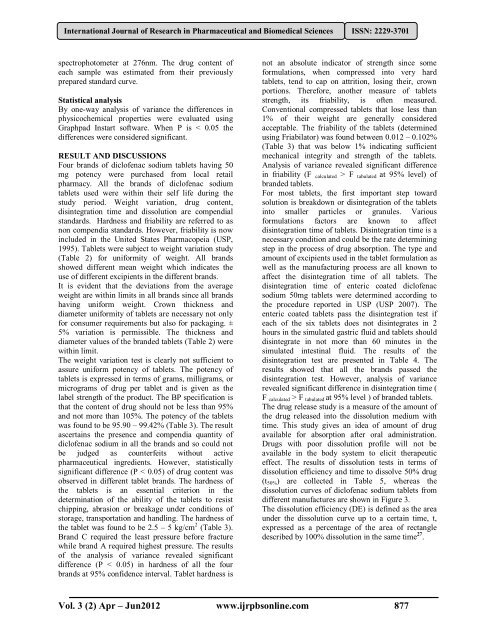In vitro Evaluation of Commercially Available ... - ResearchGate
In vitro Evaluation of Commercially Available ... - ResearchGate
In vitro Evaluation of Commercially Available ... - ResearchGate
- No tags were found...
Create successful ePaper yourself
Turn your PDF publications into a flip-book with our unique Google optimized e-Paper software.
<strong>In</strong>ternational Journal <strong>of</strong> Research in Pharmaceutical and Biomedical Sciences ISSN: 2229-3701spectrophotometer at 276nm. The drug content <strong>of</strong>each sample was estimated from their previouslyprepared standard curve.Statistical analysisBy one-way analysis <strong>of</strong> variance the differences inphysicochemical properties were evaluated usingGraphpad <strong>In</strong>start s<strong>of</strong>tware. When P is < 0.05 thedifferences were considered significant.RESULT AND DISCUSSIONSFour brands <strong>of</strong> dicl<strong>of</strong>enac sodium tablets having 50mg potency were purchased from local retailpharmacy. All the brands <strong>of</strong> dicl<strong>of</strong>enac sodiumtablets used were within their self life during thestudy period. Weight variation, drug content,disintegration time and dissolution are compendialstandards. Hardness and friability are referred to asnon compendia standards. However, friability is nowincluded in the United States Pharmacopeia (USP,1995). Tablets were subject to weight variation study(Table 2) for uniformity <strong>of</strong> weight. All brandsshowed different mean weight which indicates theuse <strong>of</strong> different excipients in the different brands.It is evident that the deviations from the averageweight are within limits in all brands since all brandshaving uniform weight. Crown thickness anddiameter uniformity <strong>of</strong> tablets are necessary not onlyfor consumer requirements but also for packaging. ±5% variation is permissible. The thickness anddiameter values <strong>of</strong> the branded tablets (Table 2) werewithin limit.The weight variation test is clearly not sufficient toassure uniform potency <strong>of</strong> tablets. The potency <strong>of</strong>tablets is expressed in terms <strong>of</strong> grams, milligrams, ormicrograms <strong>of</strong> drug per tablet and is given as thelabel strength <strong>of</strong> the product. The BP specification isthat the content <strong>of</strong> drug should not be less than 95%and not more than 105%. The potency <strong>of</strong> the tabletswas found to be 95.90 – 99.42% (Table 3). The resultascertains the presence and compendia quantity <strong>of</strong>dicl<strong>of</strong>enac sodium in all the brands and so could notbe judged as counterfeits without activepharmaceutical ingredients. However, statisticallysignificant difference (P < 0.05) <strong>of</strong> drug content wasobserved in different tablet brands. The hardness <strong>of</strong>the tablets is an essential criterion in thedetermination <strong>of</strong> the ability <strong>of</strong> the tablets to resistchipping, abrasion or breakage under conditions <strong>of</strong>storage, transportation and handling. The hardness <strong>of</strong>the tablet was found to be 2.5 – 5 kg/cm 2 (Table 3).Brand C required the least pressure before fracturewhile brand A required highest pressure. The results<strong>of</strong> the analysis <strong>of</strong> variance revealed significantdifference (P < 0.05) in hardness <strong>of</strong> all the fourbrands at 95% confidence interval. Tablet hardness isnot an absolute indicator <strong>of</strong> strength since someformulations, when compressed into very hardtablets, tend to cap on attrition, losing their, crownportions. Therefore, another measure <strong>of</strong> tabletsstrength, its friability, is <strong>of</strong>ten measured.Conventional compressed tablets that lose less than1% <strong>of</strong> their weight are generally consideredacceptable. The friability <strong>of</strong> the tablets (determinedusing Friabilator) was found between 0.012 – 0.102%(Table 3) that was below 1% indicating sufficientmechanical integrity and strength <strong>of</strong> the tablets.Analysis <strong>of</strong> variance revealed significant differencein friability (F calculated > F tabulated at 95% level) <strong>of</strong>branded tablets.For most tablets, the first important step towardsolution is breakdown or disintegration <strong>of</strong> the tabletsinto smaller particles or granules. Variousformulations factors are known to affectdisintegration time <strong>of</strong> tablets. Disintegration time is anecessary condition and could be the rate determiningstep in the process <strong>of</strong> drug absorption. The type andamount <strong>of</strong> excipients used in the tablet formulation aswell as the manufacturing process are all known toaffect the disintegration time <strong>of</strong> all tablets. Thedisintegration time <strong>of</strong> enteric coated dicl<strong>of</strong>enacsodium 50mg tablets were determined according tothe procedure reported in USP (USP 2007). Theenteric coated tablets pass the disintegration test ifeach <strong>of</strong> the six tablets does not disintegrates in 2hours in the simulated gastric fluid and tablets shoulddisintegrate in not more than 60 minutes in thesimulated intestinal fluid. The results <strong>of</strong> thedisintegration test are presented in Table 4. Theresults showed that all the brands passed thedisintegration test. However, analysis <strong>of</strong> variancerevealed significant difference in disintegration time (F calculated > F tabulated at 95% level ) <strong>of</strong> branded tablets.The drug release study is a measure <strong>of</strong> the amount <strong>of</strong>the drug released into the dissolution medium withtime. This study gives an idea <strong>of</strong> amount <strong>of</strong> drugavailable for absorption after oral administration.Drugs with poor dissolution pr<strong>of</strong>ile will not beavailable in the body system to elicit therapeuticeffect. The results <strong>of</strong> dissolution tests in terms <strong>of</strong>dissolution efficiency and time to dissolve 50% drug(t 50% ) are collected in Table 5, whereas thedissolution curves <strong>of</strong> dicl<strong>of</strong>enac sodium tablets fromdifferent manufactures are shown in Figure 3.The dissolution efficiency (DE) is defined as the areaunder the dissolution curve up to a certain time, t,expressed as a percentage <strong>of</strong> the area <strong>of</strong> rectangledescribed by 100% dissolution in the same time 27 .Vol. 3 (2) Apr – Jun2012 www.ijrpbsonline.com 877
















